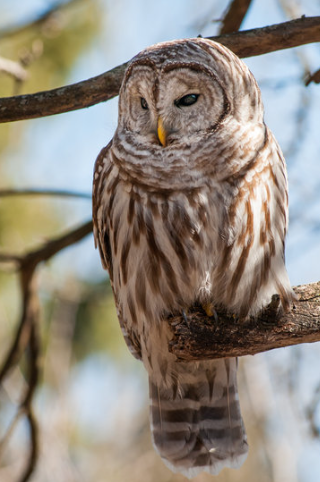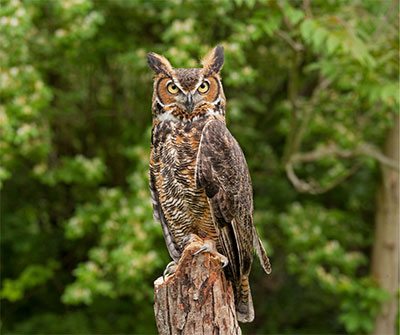Whoooo Wants to Know? Frequently Asked Questions about Owls in Johnson County
How many types of owls live in Johnson County?
 Eight species of owls can be found in Johnson County at some point during the year. The most common owls in the county are barred owls and great horned owls. Though rare, snowy owls have been observed during the winter season in this area even though their normal winter range is much further north.
Eight species of owls can be found in Johnson County at some point during the year. The most common owls in the county are barred owls and great horned owls. Though rare, snowy owls have been observed during the winter season in this area even though their normal winter range is much further north.
Are all owls nocturnal (active at night)?
No. While most owls are nocturnal, a few prefer to be up with the sun. The burrowing owl is one such species and can be found in most of central and western Kansas. Other owls are classified as crepuscular, preferring to be most active at dawn and dusk.
Where do owls nest?
Most species of owls nest in tree cavities or “snags”. A snag is a standing, dead, or dying tree that usually has visible holes and missing bark. Often, the top of a snag will break off providing a nice spot in the trunk to nest. Other owls prefer to use pre-built nests. Great horned owls can often be found using old hawk or eagle nests.
How many broods (sets of chicks) do owls have each year, and how many chicks do they have per brood?
Most owls only have one brood each year. For many species, egg laying begins in early March. Great horned owls and barred owls have on average three eggs per brood, while barn owls can have up to six eggs in a nest. Females of most species do most of the incubating, while males gather food for the nesting pair.
Do owls attack humans?
 Although extremely rare, owl attacks on humans have been known to occur. When an owl does attack, it’s usually because it perceives the human as a threat to its nest, offspring, or mate. Divebombing owls target the head when attacking, using their talons to cut deep into the scalp. The best thing a person being attacked can do is spread their arms out and be big while simultaneously making as much noise as possible.
Although extremely rare, owl attacks on humans have been known to occur. When an owl does attack, it’s usually because it perceives the human as a threat to its nest, offspring, or mate. Divebombing owls target the head when attacking, using their talons to cut deep into the scalp. The best thing a person being attacked can do is spread their arms out and be big while simultaneously making as much noise as possible.
Why should I care about owls?
Owls are essential predators that keep many species of small mammals in check. Some owl species are considered keystone species within their ecosystem. Coined by Dr. Robert Paine in 1969, a keystone species is a species that plays a disproportionately large and unique role relative to the rest of the community in supporting the healthy functions of an ecosystem. Other identified keystone species include gray wolves, beavers, and sea otters.
Sources:
- Paine, R. T. (1969). The Pisaster-Tegula Interaction: Prey Patches, Predator Food Preference, and Intertidal Community Structure. Ecology, 50(6), 950–961.
- Missouri Department of Conservation
- Kansas Department of Wildlife and Parks
